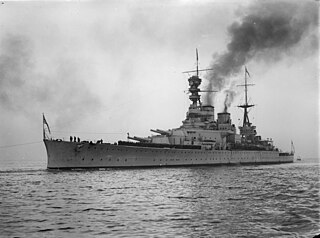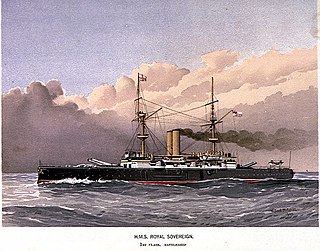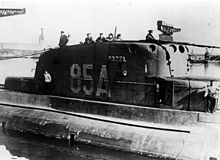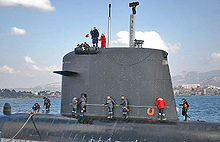
A heavy cruiser was a type of cruiser, a naval warship designed for long range and high speed, armed generally with naval guns of roughly 203 mm (8 inches) in calibre, whose design parameters were dictated by the Washington Naval Treaty of 1922 and the London Naval Treaty of 1930. Heavy cruisers were generally larger, more heavily-armed and more heavily-armoured than light cruisers while being smaller, faster, and more lightly-armed and armoured than battlecruisers and battleships. Heavy cruisers were assigned a variety of roles ranging from commerce raiding to serving as 'cruiser-killers,' i.e. hunting and destroying similarly-sized ships.

Musashi was one of four planned Yamato-class battleships built for the Imperial Japanese Navy (IJN), beginning in the late 1930s. The Yamato-class ships were the heaviest and most powerfully armed battleships ever constructed, displacing almost 72,000 long tons (73,000 t) fully loaded and armed with nine 460-millimetre (18.1 in) main guns. Their secondary armament consisted of four 155-millimetre (6.1 in) triple-gun turrets formerly used by the Mogami-class cruisers. They were equipped with six or seven floatplanes to conduct reconnaissance.

The Orion-class battleships were a group of four dreadnought battleships built for the Royal Navy (RN) in the early 1910s. The first 13.5-inch-gunned (343 mm) battleships built for the RN, they were much larger than the preceding British dreadnoughts and were sometimes termed "super-dreadnoughts". The sister ships spent most of their careers assigned to the 2nd Battle Squadron of the Home and Grand Fleets, sometimes serving as flagships. Aside from participating in the failed attempt to intercept the German ships that had bombarded Scarborough, Hartlepool and Whitby in late 1914, the Battle of Jutland in May 1916 and the inconclusive action of 19 August, their service during World War I generally consisted of routine patrols and training in the North Sea.

The Nelson class was a class of two battleships of the British Royal Navy, built shortly after, and under the terms of, the Washington Naval Treaty of 1922. They were the only British battleships built between the Revenge class, ordered in 1913, and the King George V class, ordered in 1936.

The Queen Elizabeth-class battleships were a group of five super-dreadnoughts built for the Royal Navy during the 1910s. These battleships were superior in firepower, protection and speed to their Royal Navy predecessors of the Iron Duke class as well as preceding German classes such as the König class. The corresponding Bayern-class ships were generally considered competitive, although the Queen Elizabeth class were 2 knots (3.7 km/h) faster and outnumbered the German class 5:2. The Queen Elizabeths are generally considered the first fast battleships of their day.

The Revenge class, sometimes referred to as the Royal Sovereign class or the R class, consisted of five Dreadnought battleships built for the Royal Navy in the 1910s. All of the ships were completed to see service during the First World War. There were originally to have been eight of the class, but two were later redesigned, becoming the Renown-class battlecruisers, while the other, which was to have been named HMS Resistance, was cancelled outright. The design was based on that of the preceding Queen Elizabeth class, but with reductions in size and speed to make them more economical to build.

The Renownclass consisted of two battlecruisers built during the First World War for the Royal Navy. They were originally laid down as improved versions of the Revenge-class battleships, but their construction was suspended on the outbreak of war on the grounds they would not be ready in a timely manner. Admiral Lord Fisher, upon becoming First Sea Lord, gained approval to restart their construction as battlecruisers that could be built and enter service quickly. The Director of Naval Construction (DNC), Eustace Tennyson-D'Eyncourt, quickly produced an entirely new design to meet Admiral Lord Fisher's requirements and the builders agreed to deliver the ships in 15 months. They did not quite meet that ambitious goal, but they were delivered a few months after the Battle of Jutland in 1916. They were the world's fastest capital ships upon their commissioning.

HMS Renown was the lead ship of her class of battlecruisers of the Royal Navy built during the First World War. She was originally laid down as an improved version of the Revenge-class battleships. Her construction was suspended on the outbreak of war on the grounds she would not be ready in time. Admiral Lord Fisher, upon becoming First Sea Lord, gained approval to restart her construction as a battlecruiser that could be built and enter service quickly. The Director of Naval Construction (DNC), Eustace Tennyson-D'Eyncourt, quickly produced a new design to meet Fisher's requirements and the builders agreed to deliver the ships in 15 months. They did not quite meet that ambitious goal but the ship was delivered a few months after the Battle of Jutland in 1916. Renown, and her sister HMS Repulse, were the world's fastest capital ships upon completion.

The King George V-class battleships were a group of four dreadnought battleships built for the Royal Navy (RN) in the early 1910s that were sometimes termed super-dreadnoughts. The sister ships spent most of their careers assigned to the 2nd Battle Squadron of the Home and Grand Fleets, sometimes serving as flagships. In October 1914, Audacious struck a mine and sank. Aside from participating in the failed attempt to intercept the German ships that had bombarded Scarborough, Hartlepool and Whitby in late 1914, the Battle of Jutland in May 1916 and the inconclusive action of 19 August, the surviving ships' service during the First World War generally consisted of routine patrols and training in the North Sea.

The Colossus-class battleships were a pair of dreadnought battleships built for the Royal Navy (RN) at the end of the first decade of the 20th century, the last 12-inch-gunned (305 mm) battleships built for the RN. The sister ships spent their whole careers assigned to the Home and Grand Fleets, often serving as flagships. Aside from participating in the Battle of Jutland in May 1916, and the inconclusive action of 19 August several months later, their service during the First World War generally consisted of routine patrols and training in the North Sea.

Ise was the lead ship of her class of two dreadnought battleships built for the Imperial Japanese Navy (IJN) during the 1910s. Although completed in 1917, she played no role in World War I. Ise supported Japanese forces in the early 1920s during the Siberian Intervention in the Russian Civil War. In 1923, she assisted survivors of the Great Kantō earthquake. The ship was partially modernised in two stages in 1928–1929 and 1931–1932, during which her forward superstructure was rebuilt in the pagoda mast style. Ise was reconstructed in 1934–1937, with improvements to her armour and her propulsion machinery. Afterwards she played a minor role in the Second Sino-Japanese War.

Pre-dreadnought battleships were sea-going battleships built from the mid- to late- 1880s to the early 1900s. Their designs were conceived before the appearance of HMS Dreadnought in 1906 and their classification as "pre-dreadnought" is retrospectively applied. In their day, they were simply known as "battleships" or else more rank-specific terms such as "first-class battleship" and so forth. The pre-dreadnought battleships were the pre-eminent warships of their time and replaced the ironclad battleships of the 1870s and 1880s.

Mikasa (三笠) is a pre-dreadnought battleship built for the Imperial Japanese Navy (IJN) in the late 1890s, and is the only ship of her class. Named after Mount Mikasa in Nara, Japan, the ship served as the flagship of Vice Admiral Tōgō Heihachirō throughout the Russo-Japanese War of 1904–1905, including the Battle of Port Arthur on the second day of the war and the Battles of the Yellow Sea and Tsushima. Days after the end of the war, Mikasa's magazine accidentally exploded and sank the ship. She was salvaged and her repairs took over two years to complete. Afterwards, the ship served as a coast-defence ship during World War I and supported Japanese forces during the Siberian Intervention in the Russian Civil War.

HSwMS Sverige was a Sverige-class coastal defence ship (Pansarskepp) commissioned by Sweden during the last year of the First World War. The ship cost approximately 12 million kronor, a sum raised entirely by public donations. The fundraising was done because of the Karl Staaff government's reluctance to spend money on a new battleship. In addition to its impressive cost, the ship also had a significant impact on the Swedish Navy and its capabilities.
Secondary armaments are smaller, faster-firing weapons that are typically effective at a shorter range than the main (heavy) weapons on military systems, including battleship- and cruiser-type warships, tanks/armored personnel carriers, and rarely other systems.

Tsesarevich was a pre-dreadnought battleship of the Imperial Russian Navy, built in France at the end of the 19th century. The ship's design formed the basis of the Russian-built Borodino-class battleships. She was based at Port Arthur, northeast China, after entering service and fought in the Russo-Japanese War of 1904–1905. Tsesarevich was torpedoed during the surprise attack on Port Arthur and was repaired to become the flagship of Rear Admiral Wilgelm Vitgeft in the Battle of the Yellow Sea and was interned in Qingdao after the battle.

The Andrei Pervozvanny class were a pair of pre-dreadnought battleships built in the first decade of the twentieth century for the Baltic Fleet of the Imperial Russian Navy. They were conceived by the Naval Technical Committee in 1903 as an incremental development of the Borodino-class battleships with increased displacement and heavier secondary armament. The disastrous experiences of the Russo-Japanese War of 1904–1905 and the unrest resulting from the 1905 Russian Revolution led to countless redesigns, change orders and delays in construction. Despite the designers' repeated attempts to modernize the ships while under construction, they were obsolete in concept from the beginning, and even more so when they entered service in 1911.

Asahi was a pre-dreadnought battleship built for the Imperial Japanese Navy (IJN) in the late 1890s. As Japan lacked the industrial capacity to build such warships itself, the ship was designed and built in the United Kingdom. Shortly after her arrival in Japan, she became flagship of the Standing Fleet, the IJN's primary combat fleet. She participated in every major naval battle of the Russo-Japanese War of 1904–1905 and was lightly damaged during the Battle of the Yellow Sea and the Battle of Tsushima. Asahi saw no combat during World War I, although the ship participated in the Siberian Intervention in 1918.

Jean Bart was the second of four Courbet-class battleships, the first dreadnoughts built for the French Navy. She was completed before World War I as part of the 1910 naval building programme. She spent the war in the Mediterranean and helped to sink the Austro-Hungarian protected cruiser Zenta on 16 August 1914. She was torpedoed by an Austro-Hungarian submarine in December and steamed to Malta for repairs that required three and a half months. She spent the rest of the war providing cover for the Otranto Barrage that blockaded the Austro-Hungarian Navy in the Adriatic Sea and sometimes served as a flagship.

The Shikishima class was a two-ship class of pre-dreadnought battleships built for the Imperial Japanese Navy in the late 1890s. As Japan lacked the industrial capacity to build such warships itself, they were designed and built in the UK. The ships participated in the Russo-Japanese War of 1904–1905, including the Battle of Port Arthur on the second day of the war. Hatsuse sank after striking two mines off Port Arthur in May 1904. Shikishima fought in the Battles of the Yellow Sea and Tsushima and was lightly damaged in the latter action, although shells prematurely exploded in the barrels of her main guns in each battle. The ship was reclassified as a coast defence ship in 1921 and served as a training ship for the rest of her career. She was disarmed and hulked in 1923 and finally broken up for scrap in 1948.
























